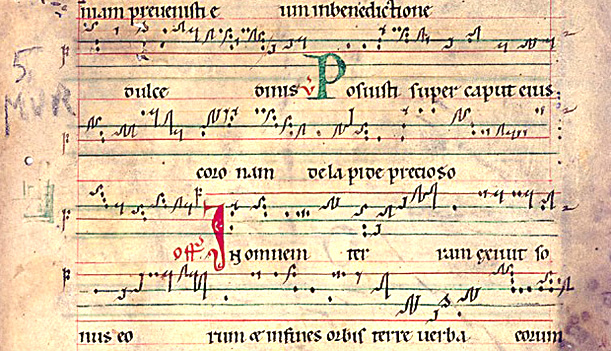The Evolution of the Treble Clef
For centuries, music notation was an inexact technique and hasty transcriptions may have resulted in this symbol
The curving flourishes of music notation have always been something a mystery to me, although every day I, like many people, use other arcane symbols without thinking twice about it. The at (@) sign, the dollar sign ($) and the ampersand (&), for example, all function like ligatures or some sort of shorthand. They’ve been demystified by popular use in email, clues on “Wheel of Fortune,” and their inclusion on computer keyboards. But music notation is a semantic system that is entirely different from the written word; a non-spoken alphabet of pitch and rhythm. So, with apologies to the more musically inclined reader, I looked into the origin of the treble clef and the answer was quite simple. The treble clef, the top symbol you see in the photo above, is also known as the G-clef, which gives you the first clue to its origin.
So for my own edification, if nothing else, let’s start with the basics. A clef is a sign placed on a music staff that indicates what pitch is represented by each line and space on the staff. The history of Western musical notation describes an effort toward the development of a simple, symbolic representations of pitch and rhythm. It begins near the end of the 9th century when notation for the Plainsong of the Western Church, better known as Gregorian Chant, was first recorded with “neumes”. These were simple dashes or dots above lyrics that indicated a relative change in pitch. At the end of the 10th century, musical scribes increased the precision of his early notation by introducing a horizontal line to indicate a base pitch (see above image). The pitch of this line was indicated by a letter at its start – typically F or C and, as higher range songs become more common, G. Neumes were no longer relative only to one another, but to a standard. This was the beginning of the musical staff.

Another example of 12th century notation. Note the variation of the letter F to the left of each read line. (image: The Schøyen Collection)
These initial letters evolved over time into the stylized representations that we know as clefs today. The treble clef is a standardized representation of the letter G, while the bass clef, also known as the F-clef, is a more dramatic unrecognizable evolution of the letter F. A possible addition to this evolution was suggested in a 1908 article in The Musical Times, which argued that the contemporary form of the treble clef is a result of 17th century notational technique in which multiple symbols were used indicate both pitch and vocal sound, with “G, Sol” being a common combination that was eventually shortened to G.S. and then “gradually corrupted by careless transcription” into the treble clef.
In a time before mechanical reproducibility, the standardization of signs was an unfamiliar concept. These notations were all written by hand the inconsistencies and idiosyncrasies of each scribe naturally resulted in some variability of representation, sometimes even on the same page. And, don’t forget, the handwriting was noticeably fancier than today’s script – think medieval font. I can imagine that the scribes tasked with copying these notational manuscripts made mistakes and additions, until eventually the copy (of the copy, of the copy…) bore little resemblance to the original.
Use of the C-clef, also known as the alto clef and tenor clef depending on its position, has declined over the 20th century to be replaced by the other two. Today, the alto clef is used primarily in viola music while the tenor is occasionally used for bassoon, trombone and cello. The F-clef is used for lower-brass notation as well as for the bass and, every kid who was forced to take piano lessons knows, the left hand of keyboard instruments. The instruments that use treble clef include the violin, woodwinds, higher brass instruments, and of course the right hand of keyboard instruments. Its wide use has led it becoming cartoon shorthand to graphically indicate musicality. It seems appropriate that its development was incidental to the preservation and proliferation of the music itself.
Sources:
Harper College History of Western Music, eds, Hugh M. Miller and Dave Cockrell (1991); Harvard Dictionary of Music, ed. Willi Apel (1971); Karl Wilson Gehrkens, Music Terminology and Notation (1914); Frank Kidson, “The Evolution of Clef Signatures,” The Musical Times (July 1, 1908); The Schøyen Collection
/https://tf-cmsv2-smithsonianmag-media.s3.amazonaws.com/accounts/headshot/Jimmy-Stamp-240.jpg)



/https://tf-cmsv2-smithsonianmag-media.s3.amazonaws.com/accounts/headshot/Jimmy-Stamp-240.jpg)